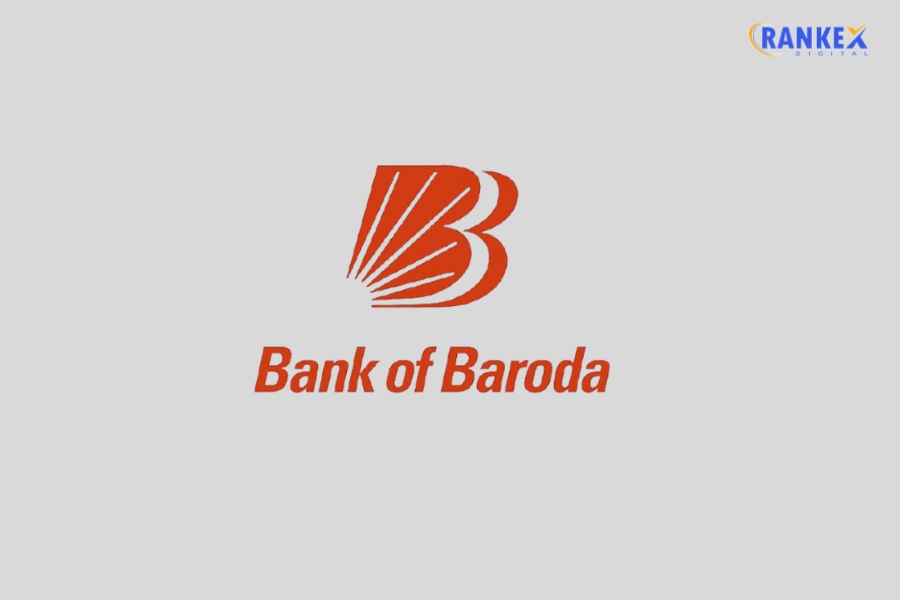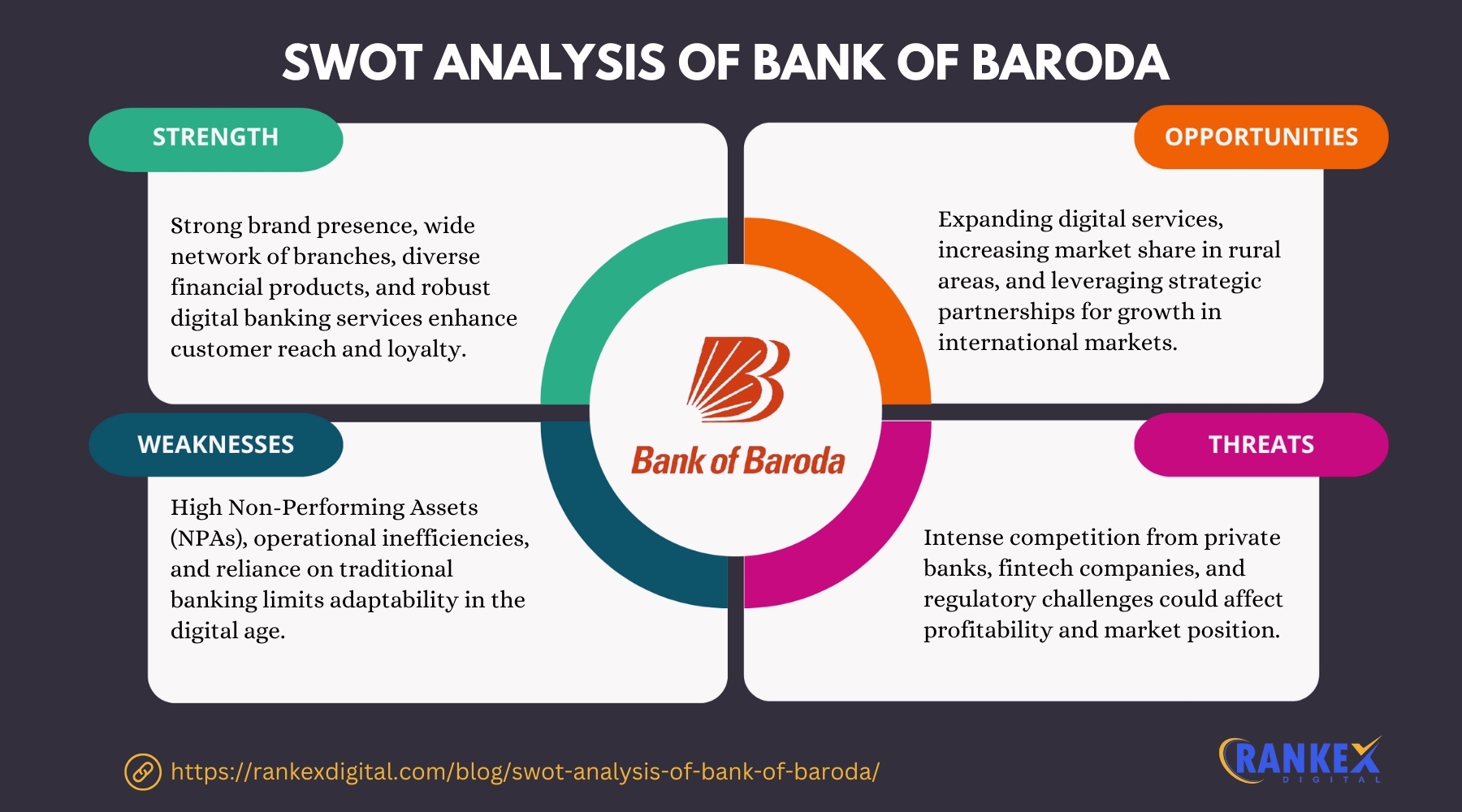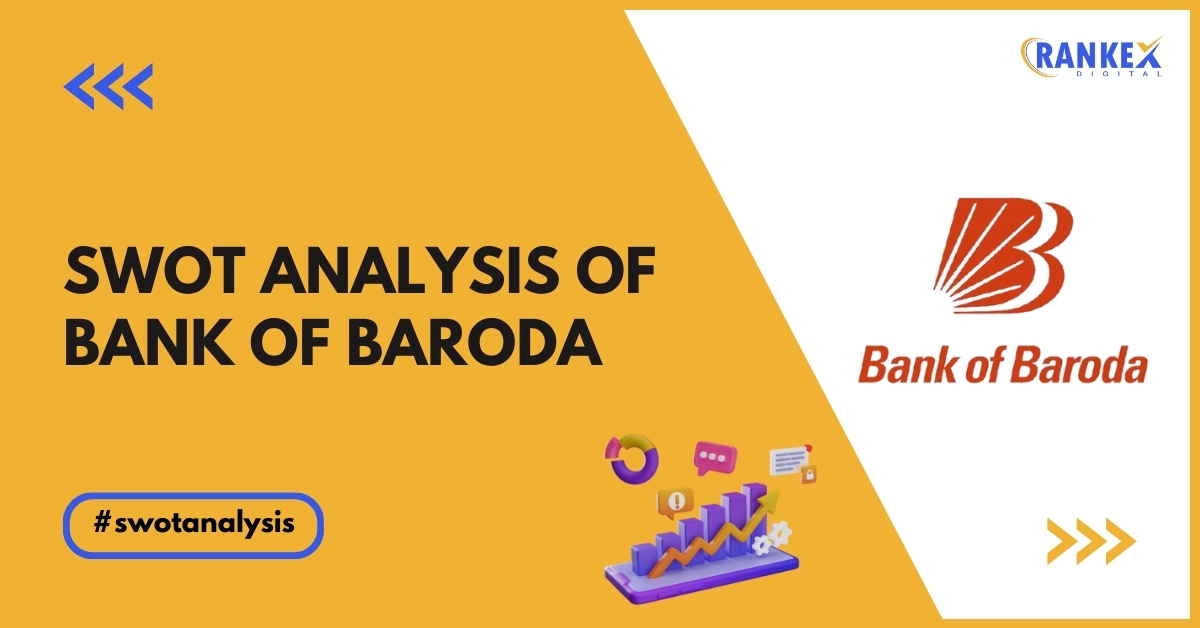Bank of Baroda (BoB) is one of India’s leading public sector banks with a long and illustrious history, offering a broad spectrum of banking services to its customers. As one of the top banks in the country, it plays a critical role in India’s financial landscape.
Understanding the strengths, weaknesses, opportunities, and threats (SWOT) of the Bank of Baroda is essential to gauge its position in the market and strategize for future growth. This article delves into a detailed SWOT analysis of Bank of Baroda, outlining its key attributes, challenges, and opportunities.
Table of Contents
Overview of Bank of Baroda

Established in 1908 in Baroda (now Vadodara), Gujarat, the Bank of Baroda has grown to become a prominent financial institution in India and beyond. It offers a wide range of banking services, including retail banking, corporate banking, investment banking, and wealth management.
Headquartered in Vadodara, Gujarat, Bank of Baroda operates more than 9,500 branches across the country and has an international presence in over 25 countries. Known for its customer-centric approach, the bank has garnered a large customer base, contributing significantly to its growth over the years.
Quick Stats About Bank of Baroda
| Attribute | Details |
|---|---|
| Founder | Maharaja of Baroda |
| Year Founded | 1908 |
| Headquarters | Vadodara, Gujarat, India |
| No. of Employees | Over 60,000 |
| CEO | Sanjiv Chadha |
| Company Type | Public |
| Market Cap | $15 Billion (approx.) |
| Annual Revenue | $6 Billion (approx.) |
| Net Profit | $600 Million (approx.) |
Current News of Bank of Baroda
- Digital Transformation: Bank of Baroda has been investing in advanced digital banking services, including mobile banking and online loan applications, to improve customer experience.
- Expansion in International Markets: The bank is expanding its reach globally with a special focus on markets in the Middle East and Southeast Asia.
- Focus on Financial Inclusion: The Bank of Baroda has been working toward enhancing financial inclusion in rural and semi-urban areas of India through various initiatives and schemes.
SWOT Analysis of Bank of Baroda

Strengths of Bank of Baroda
- Strong Brand Recognition:
Bank of Baroda’s reputation spans over 100 years, which has earned it strong brand loyalty, especially in India. This historical trust allows it to attract both new customers and retain existing ones. It is well-regarded for its sound financial practices and service offerings. - Wide Branch Network:
Bank of Baroda’s extensive presence across India and in international markets enables it to cater to a large and diverse customer base. The large network of branches and ATMs makes it easy for customers to access services, even in remote regions. - Diversified Product Portfolio:
The bank offers a broad range of products, from personal banking services like savings and current accounts to corporate banking solutions and wealth management. It also has digital banking platforms, helping meet the varied needs of individuals and businesses. - Government Support:
As a public sector bank, the Bank of Baroda benefits from strong backing by the Indian government, providing financial stability. The association with the government also inspires customer confidence and reliability, especially during financial crises. - Robust Digital Infrastructure:
With the growing demand for digital banking, the Bank of Baroda has heavily invested in online services. Its mobile app and internet banking platforms offer features such as instant fund transfers, mobile recharge, and bill payments, making it easier for tech-savvy customers to conduct transactions.
Weaknesses of the Bank of Baroda
- High Non-Performing Assets (NPAs):
NPAs are a major challenge for public sector banks in India, and Bank of Baroda is no exception. High NPAs can affect its profitability, reduce investor confidence, and slow down its ability to lend. - Bureaucratic and Slow Decision-Making:
As a state-run entity, the Bank of Baroda may face internal challenges in decision-making due to government regulations and bureaucratic structures. This can delay the bank’s ability to swiftly adapt to changes in the financial landscape or seize market opportunities. - Limited International Presence:
While the Bank of Baroda operates in several international markets, its global presence is still limited compared to some of its private-sector competitors like ICICI and HDFC. Expanding further into emerging economies could provide new growth opportunities. - Operational Inefficiencies:
Managing such a large network of branches and staff can create operational inefficiencies. The bank’s extensive infrastructure can lead to higher operational costs and difficulties in maintaining standardized service quality across all regions. - Dependence on Interest Income:
Bank of Baroda’s revenue is heavily reliant on interest income from loans, making it vulnerable to interest rate changes and economic fluctuations. A downturn in the economy or a change in monetary policy can directly affect its profitability.
Opportunities for Bank of Baroda
- Digital Banking Growth:
With the rise in digital banking, especially among the younger generation, Bank of Baroda has the chance to further enhance its digital offerings. Expanding its e-banking services, such as online loan applications and digital payments, can help capture a larger market share. - Expansion in Rural and Semi-Urban Areas:
The rural and semi-urban markets in India remain underserved by financial institutions, creating a huge opportunity for Bank of Baroda. By focusing on financial inclusion, it can tap into these segments and broaden its customer base. Expanding micro-lending and offering tailor-made products for these areas could boost growth. - Collaborations with Fin-techs:
Partnering with fintech companies could allow Bank of Baroda to leverage new technologies such as artificial intelligence, blockchain, and machine learning. These partnerships could enhance the bank’s efficiency, security, and ability to provide innovative products. - International Expansion:
Bank of Baroda could continue to expand its international footprint, especially in regions with growing economies such as Africa, Southeast Asia, and the Middle East. International expansion can offer new revenue streams and reduce dependency on the domestic market. - Diversification of Products and Services:
Introducing new services such as insurance products, retirement plans, and wealth management solutions could help diversify its income sources and appeal to a broader customer base. This could also strengthen its competitive edge in the market.
Threats to Bank of Baroda
- Intense Competition:
The Indian banking sector is highly competitive, with numerous private sector banks (e.g., HDFC, ICICI, Axis) and other public sector banks vying for market share. To maintain its position, Bank of Baroda must continually innovate and improve its offerings. - Regulatory Changes:
Changes in government regulations and banking policies can have a significant impact on Bank of Baroda’s operations. New lending policies, changes in tax laws, or stricter compliance regulations could increase operational costs or affect its lending portfolio. - Economic Slowdown:
A slowdown in India’s economy or global economic challenges could affect consumer spending and loan repayments. Economic downturns, inflation, or rising unemployment rates could lead to higher default rates, which would hurt the bank’s profitability. - Cybersecurity Risks:
With the increase in digital banking, cybersecurity threats such as hacking, phishing, and data breaches have become major concerns. Bank of Baroda must invest heavily in maintaining robust security systems to protect its customers’ sensitive data and maintain trust. - Interest Rate Fluctuations:
As a bank dependent on interest income, the Bank of Baroda is vulnerable to changes in interest rates. Rising interest rates could slow down demand for loans, while falling rates may reduce the income generated from existing loans.
Conclusion
Bank of Baroda has established itself as one of India’s leading public sector banks, boasting a strong brand reputation, a wide branch network, and a diversified product portfolio. However, it faces challenges such as high NPAs, bureaucratic inefficiencies, and competition from both private and public sector banks.
To secure its future growth, the bank can capitalize on opportunities in digital banking, rural expansion, and strategic partnerships while addressing its weaknesses and managing external threats.
Frequently Asked Questions
- What are the key strengths of the Bank of Baroda?
Bank of Baroda’s strengths include its strong brand recognition, extensive branch network, diversified product offerings, government support, and robust digital infrastructure. - What challenges does the Bank of Baroda face?
Bank of Baroda faces challenges such as high non-performing assets (NPAs), slow decision-making due to bureaucratic processes, operational inefficiencies, and a limited international presence. - How is the Bank of Baroda addressing digital banking growth?
Bank of Baroda has made significant investments in digital banking, offering services such as mobile banking apps, online loan applications, and digital payments to cater to the growing demand for online banking solutions. - What opportunities lie ahead for the Bank of Baroda?
Key opportunities for Bank of Baroda include expanding its digital offerings, growing its presence in rural and semi-urban areas, collaborating with fintech companies, and diversifying its product portfolio to attract new customers. - Who are the major competitors of the Bank of Baroda?
Bank of Baroda faces intense competition from other Indian banks such as HDFC Bank, ICICI Bank, Axis Bank, and other public sector banks like Punjab National Bank.











